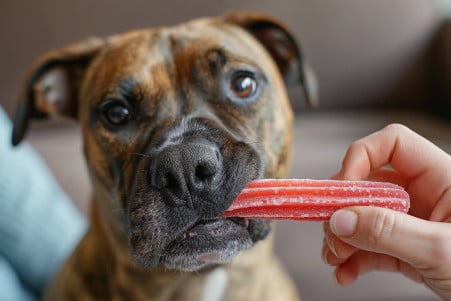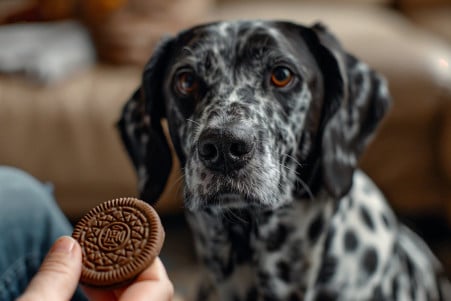Can Dogs Eat Black Licorice? Understanding the Risks
15 March 2024 • Updated 15 March 2024

If you’re thinking about giving your dog some black licorice, it’s important to take your dog’s health into account. Dogs cannot eat black licorice. This is because glycyrrhizin, a compound found in black licorice, is toxic to dogs and can cause an increase in blood pressure, muscle weakness, and vomiting. Ingesting large amounts of black licorice can have serious consequences for dogs, so it’s best to avoid giving it to them.
In the sections below, we’ll delve into veterinary knowledge and nutritional research to explain why black licorice is bad for dogs. We’ll also look at research that has been done on the impact of glycyrrhizin, a component of licorice, on dogs and discuss the broader dietary requirements and limitations of dogs. Our in-depth exploration of dog-friendly foods will cover the dangers of some treats and help you find better options for your furry friend.
Can dogs eat black licorice?
Glycyrrhizin Toxicity in Dogs
Glycyrrhizin, a component of black licorice, has been shown to be a health risk to dogs in high doses. This compound, which is derived from the licorice root, can cause hypertension and other symptoms like muscle weakness, and vomiting in dogs. One article on PubMed explains that glycyrrhizin can cause hypertension and hypokalemic-induced secondary disorders when ingested in high amounts.
Because long-term exposure to glycyrrhizin can cause life-threatening conditions like chronic hypertension and hypokalemic-induced disorders, it’s important for dog owners to know the signs of toxicity and what to do if their dog is exposed. If your dog eats black licorice that contains glycyrrhizin, The Dog People by Rover.com recommends calling your vet immediately and keeping a close eye on your dog for any symptoms.
Knowing the risks of glycyrrhizin can help dog owners protect their pets. If an exposure occurs, seeking veterinary treatment right away can help ensure your pet’s safety.
Sugar and How It Affects Dogs
In addition to the potential for toxicity, sugar is a common ingredient in many human treats and can have negative effects on dogs.
Although not poisonous, sugar can cause a number of health issues including obesity, metabolic changes, diabetes, and even pancreatitis over time, according to PetMD. In addition to reducing a dog’s quality of life, these issues can also lead to other health problems in the future.
For example, black licorice is a type of candy that is high in sugar and can be especially problematic for dogs. This is because dogs process sugar differently than humans, so a small amount of candy for a person can be a sugar overload for a dog.
Dogs that have consumed too much sugar may experience an upset stomach, weight gain, and changes in their energy levels. To avoid these issues, it’s best to keep treats to no more than 10% of a dog’s diet and to only offer natural sugars from fruits in moderation.
By controlling the amount of sugar your dog consumes, you can help ensure that they stay healthy and happy. This dietary approach also makes room for the introduction of safe and nutritious alternatives that will satisfy a dog’s taste buds without putting their health at risk.
Better Snack Options for Your Dog
Instead of giving your dog black licorice as a treat, you should opt for something healthier. There are many fruits and vegetables that you may already have in your kitchen that are not only safe for dogs but also good for them.
For example, seedless apples, carrots, and blueberries are all listed by Raleigh Vet as great treats that are nutrient-dense, high in fiber, and low in calories compared to many commercial treats. Plus, these whole foods are easy to grab and help maintain a healthy weight for your dog.
When you introduce new treats to your dog, do it slowly. You should also start with small amounts to see how your dog’s stomach reacts to them, according to the Tufts University of Veterinary Medicine.
You should also make sure to give treats in moderation, since even healthy treats can throw off your dog’s diet if they’re given too much. You should also make sure to give them great options, like homemade snacks made from cooked squash or unsweetened pumpkin, to make sure that you’re giving them a variety of foods that are both appealing and safe.
Making homemade treats can also help you improve your dog’s diet. For example, Purina recommends using lean meats like chicken or nutrient-dense vegetables like green beans and broccoli.
However, you should make sure to introduce these treats slowly and watch your pet’s reaction to make sure that they’re healthy. If your dog’s tail is wagging and they’re looking at you with excitement, you’ll know that you’ve made the right choice for their health and happiness.
Canine Dietary Restrictions
If you’re a dog owner, you should know which foods are toxic to dogs. For example, the American Kennel Club lists chocolate, grapes, and xylitol as some of the most common ingredients that are toxic to dogs, and all of them can lead to a range of health problems, including death.
This is because the canine digestive system is not well-equipped to handle certain types of food, especially those that are high in fat and complex carbohydrates, according to the Whole Dog Journal. Dogs don’t have enough of the enzymes that are required to effectively break down these substances.
In order to avoid dietary-related health problems, dog owners need to make sure they’re feeding their pets a well-balanced diet and that they’re careful about giving their dogs human food as a treat.
For example, while garlic and onions are often considered healthy for people, they can be extremely toxic to dogs because they contain certain compounds that can lead to anemia and other health problems, according to Healthline.
To make sure that they’re keeping their pets safe and healthy, dog owners need to make sure they’re following the guidelines for a healthy dog diet and that they understand the risks associated with human food. It’s also important to work with a veterinarian to make sure that the diet they’re feeding their dog meets their pet’s specific nutritional needs while avoiding toxic foods.
Final Thoughts on Dogs and Black Licorice
In summary, black licorice is a food that can be very dangerous for dogs due to the toxic effects of glycyrrhizin and the high sugar content. As noted earlier, glycyrrhizin can cause a dog’s blood pressure to rise and lead to other health problems if it’s consumed in large amounts.
Meanwhile, the high sugar content in black licorice candies can lead to obesity, diabetes, and tooth decay, which makes them a poor choice for dogs.
Dog owners should be aware of these dietary risks and make sure to look for safe, healthy alternatives when choosing treats for their pets. It’s also important to make sure that you’re feeding your dog a diet that’s well-rounded and includes a variety of different foods and to make sure that you’re introducing new treats in a way that’s safe for your pet.
As the people who are responsible for our pets’ health, it’s our job to make sure that we’re feeding them a diet that’s balanced and safe and to make sure that we’re not feeding them anything that’s harmful.
If you’re not sure what you should be feeding your dog, it’s a good idea to talk to your vet so that you can get advice that’s tailored to your pet’s specific nutritional needs and health concerns.
By making sure that we’re educated and proactive about what we’re feeding our pets, we can make sure that they’re living their best lives and enjoying all of the tail-wagging happiness that comes with it.


